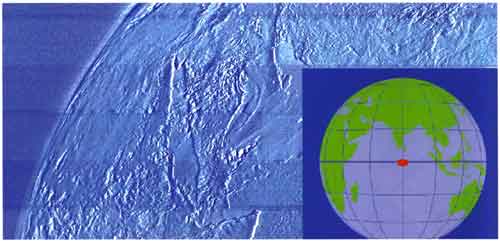The second command center of the space-based early-warning system is reported to have entered combat duty on 30 April 2012. The command center is located near Komsomolsk-on-Amur (see the map below).
Its Western counterpart, known as Serpukhov-15, is located near Kurilovo in the Kaluga region.
According to the report quoted above, construction of the Eastern command center began in 1981. In 1991, the center entered trials and on December 10, 2002 began experimental combat service.
The Eastern command center was supposed to service geostationary early-warning satellites deployed in the three eastern points reserved for the satellites of the US-KMO system - 130E, 166E, and 159W (see my article on the early-warning system). However, no satellites have been deployed in these points. The center could probably also control satellites deployed on highly-elliptical orbits as they pass the apogee that is not seen from the Western command center.
A photo account of the visit to the Eastern Command Center site contains a very interesting image that shows how the early-warning satellite sensors see the Earth. It's interesting to compare it to the image that was published earlier in a book by the Kometa Design Bureau:

As far as I can tell from the operator terminals, the system divides its zone of responsibility to seven sectors ("directions"). Apparently one sector is for each of the geostationary satellites - the only one working that day was Spacecraft No. 03 (KA No. 03) covering Sector No. 2 - recently launched Cosmos-2479 deployed in the point 80E. On what appears to be a local terminal, the system produces three options - "single target", "group of targets", "massive launch". There are separate indicators for "interference" (or "noise"), which probably tell the operator that the data might not be reliable. And, of course, there is one indicator for "false alarm".
Once the information goes to the Central Command Center (and the Reserve Command Center), the terminal no longer has the "massive launch" option. Instead, it shows the number of detected targets (three digits are reserved for this one in each sector) and the number of confirmed targets - for some reason, there is only one digit reserved for that, as if the designers never expected a satellite to see more than nine missiles. One would think that a "massive launch" would involve more than that.
Another interesting feature of the Central Command Center exchange terminal is the "imitation" indicator, which presumably tells the operator that the data displayed are coming from a training program. This is a bit unsettling - what if this particular light goes off at the wrong moment? Well, there is a "real-life work" indicator next to, which would presumably be off at the time of a training run. But if neither light is on (for whatever reason), the operator would have an interesting decision to make.
It is not clear what is the point of brining the command center into operation right now - Cosmos-2479 was the last US-KMO satellite, so the system will never become fully operational. The new system that is in the works, EKS, will definitely use a more modern equipment. Its launch has been delayed for several years, but the first flight might take place in a year or so. One the other hand, most of the infrastructure of the command center - communication antennae and the buildings - will probably be used in the new system as well.

Comments
I'm presuming from this that 80E can be controlled by either centre. Imitation could be decoys?
Novosti Kosmonavtiki has put its photo set up:
http://www.novosti-kosmonavtiki.ru/content/photogallery/gallery_235/index.shtml